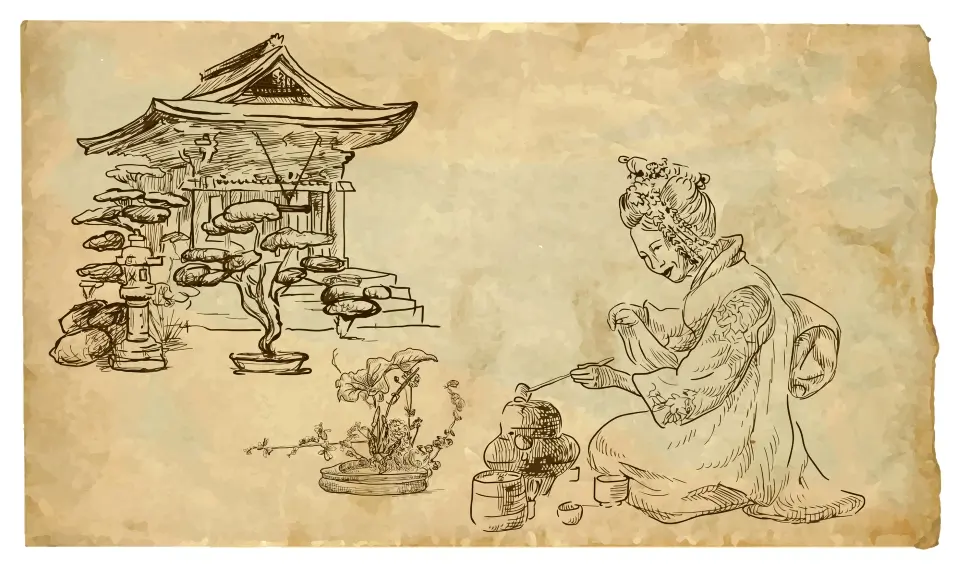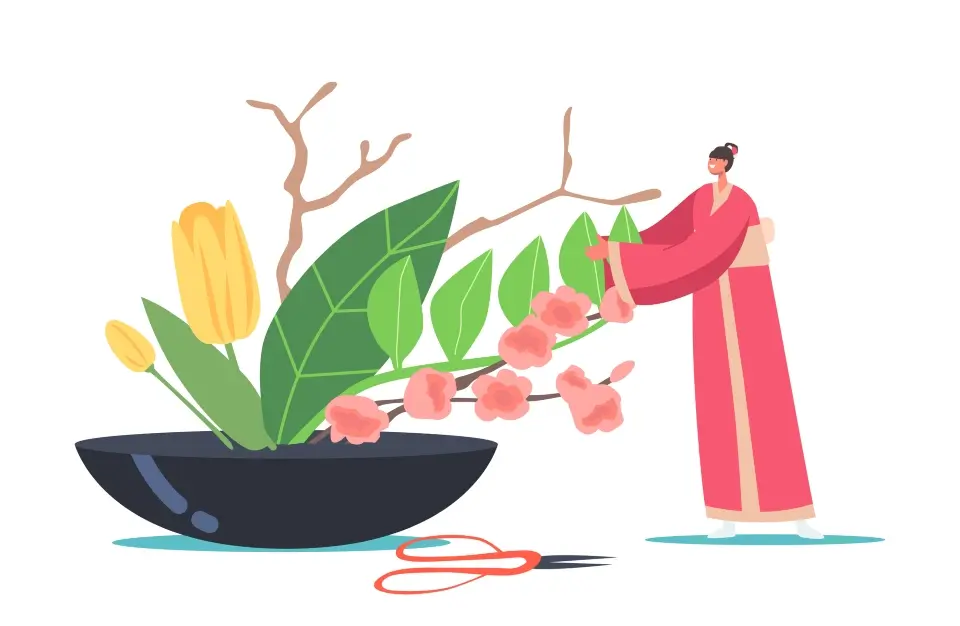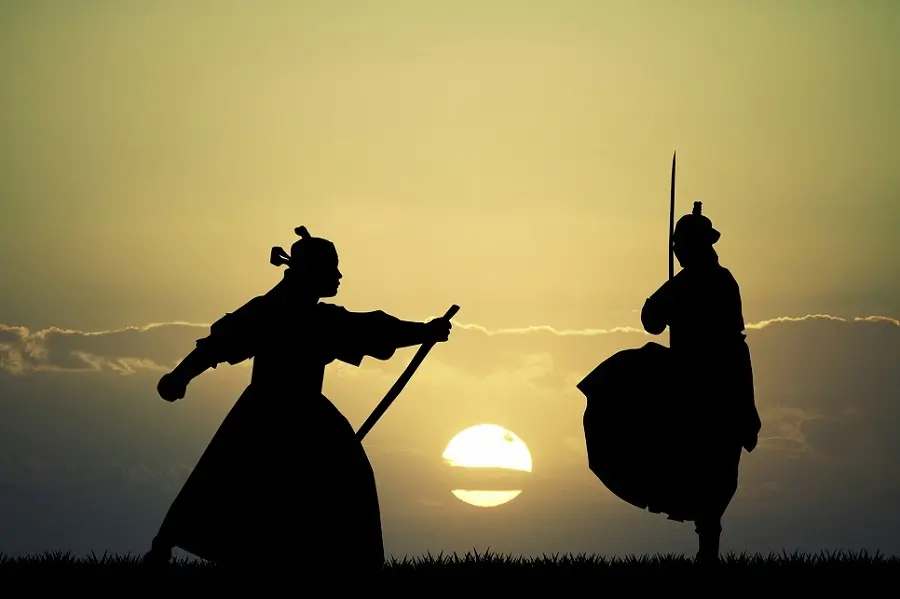Japan: From Traditional Practices to Modern Cultural Innovations

Japan, an archipelago in the Pacific Ocean, has intriguing contrasts and “harmonious contradictions”. The country is an amazing mix of ancient customs, culture, and state-of-the-art technology.
Japan has a strong culture that mixes its history and old customs with new ideas and the ability to overcome challenges to create a successful modern society.
This article explores this fascinating duality, the ceaseless dance between the old and the new, the meeting point of respect for tradition, and the quest for the future.
Building the Future on The Foundations of Past Wisdom
From the bustling streets of Tokyo to the quiet rural landscapes, Japan reveals itself through many facets.
In old traditions, such as tea ceremonies, Japan uses new technology, like virtual reality. The samurai’s ‘Bushido’ rules are still used in today’s businesses. Stories in Manga combine old and new Japan. The ever-present ‘Konbini’ stores show city life and the world loves Japanese whiskey because Japan always tries to make things perfect.
Japan’s relationship with nature is also very interesting, especially in its old ways of caring for the environment.
You can see it in practices such as ‘mottainai’ and ‘satoyama’ or the influence of natural disasters on Japan’s art, literature, and language.
Combining the above concepts with the vibrant streets of Harajuku, the spirit of Japan’s youth comes alive in a kaleidoscope of fashion trends, each telling a unique story of social influences and subcultures like Otaku and Kawaii.
Embarking on this journey, Let’s delve deeper into these aspects of Japanese culture. Let’s look deeply at a nation that gracefully balances its profound respect for the past with its ambitious vision for the future.
Come with me to explore Japan, where old customs meet new technology. Here, the stories of the past mix with today’s ways, and every part of the culture shares a special story of coming together, being different, and changing over time.
Bridging Traditions and Technology
In Japan, centuries-old traditions coexist harmoniously with futuristic technologies. It’s a unique cultural landscape where the spiritual richness of the past complements the digital innovation of the present.
As we examine Japanese culture closely, we see big changes happening. These changes involve combining new technologies like virtual reality, computer intelligence, and digital art with old Japanese traditions like tea parties, kabuki plays, origami, and Ikebana flower arrangements.
The Digital Revamp of Traditional Practices
Tea Ceremonies:

The old tea ceremony, called “sado,” is a special event that shows peace, honor, cleanliness, and calm. Now, with virtual reality, more people can easily learn and enjoy this old custom.
Now, with virtual sado experiences, people can feel like they’re really in the peaceful tea-making world, watching closely and even pretending to do the ceremony. How does using this digital way change how people see and value Sado?
Sony Computer Science Laboratories (Sony CSL) has established a research center in the heart of Kyoto, conceived “with a view to an evolutionary future for chanoyu [tea ceremony] culture.” This endeavor collaborates with the Sabie Cultural Institute, affiliated with the esteemed Urasenke School of Tea Ceremony.
The research center, known as Jakuin, is technologically advanced. Its ceiling is outfitted with four time-of-flight sensors, which measure the distance to objects based on the time it takes for light to reflect back from them.
This cutting-edge project by Sony CSL allows students to observe and replicate an instructor’s movements.
After practice, students can view their performance from a third-person perspective, enabling them to assess the accuracy of their movements and the proper arrangement of utensils.
Kabuki Theater:
With its extravagant costumes and dramatic storytelling, Kabuki has long been a pillar of Japanese culture.
Nowadays, some kabuki shows use computer intelligence and digital pictures to create beautiful backgrounds and special effects, making the show even better for today’s viewers. Can these digital changes help keep this old art alive for our kids and grandkids?
NTT, a company that knows people want virtual spaces to feel more real, is leading in using XR (extended reality) technology. They aim to give people richer ways to connect and feel like they are really inside the virtual world.
NTT Laboratories, with its cutting-edge technology, has ventured into providing novel aural and visual experiences by blending the realms of the real and the virtual.
To showcase its avant-garde XR, NTT selected the traditional Japanese theater form of kabuki, renowned for its intricate fusion of drama, dance, and elaborate costumes, as its medium.
This initiative, titled “Cho-Kabuki Powered by NTT,” was a collaborative venture between NTT, the telecommunications and media firm Dwango, and film and kabuki production powerhouse Shochiku.
There was a special event at Makuhari Messe in Chiba Prefecture. This event showcased new production techniques, making the people watching feel like they were on the stage and deeply into the story.
Ikebana: Transition from Traditional to New Ways

Ikebana, which is about arranging flowers, is also changing with technology. Now, there are things like AR (Augmented Reality) lessons and computer-made flower designs. But there’s a question: Is using technology taking away the special spirit of ikebana? Or is it making the tradition even more exciting and alive?
Advancements in technology have opened the door for digital platforms and apps to provide immersive experiences in traditional arts.
For instance, imagine an application offering a 3D simulation of various flowers and vases, enabling enthusiasts to craft their own virtual Ikebana arrangements. Such innovations blend tradition with modernity, making age-old practices more accessible to a new generation. This mobile app is an example of this.
Technology in Celebrating Japanese Festivals
Many traditional festivals, or “matsuri,” have been held virtually due to the COVID-19 pandemic.
For example, the famous Awa Odori festival was streamed online, featuring performances from different dance troupes and allowing viewers to participate from home.
Another example is the Tanabata Festival in Sendai, which was held online and included workshops, a virtual tour of the city’s decorations, and streamed performances.
Advancements for Exhibiting Art:
TeamLab, a renowned art collective in Japan, is known for its digital art installations that blend technology with traditional Japanese art concepts. They’ve created immersive and interactive exhibitions, both physically (such as the Digital Art Museum in Tokyo) and virtually.
Public Reception & Preservation of Tradition
As the virtual and traditional boundaries blur, one wonders, “How is the Japanese public reacting to these changes?” Preliminary feedback suggests a mix of excitement and apprehension.
Many young Japanese people appreciate these digital introductions, viewing them as a cool, accessible way to connect with their heritage. On the other hand, purists fear that these practices’ essential philosophy and values may be lost in translation.
As we delve deeper into this intriguing fusion, we uncover stories of artisans and technologists working together. This joint work ensures that these traditions’ digital evolution does not compromise their inherent values.
Modern tech companies are implementing various safeguards, like integrating educational modules about the history and significance of these practices in virtual experiences. This is also changing the norms of traditional Japanese work culture.
The Ongoing Fusion of Japanese Traditions with Technology
The fusion of traditional culture and cutting-edge technology in Japan is more than an intriguing paradox. It’s a testament to the country’s resilience and adaptability, embodying its ethos of maintaining harmony between contrasting elements.
As Japan strides into the future, it is vital to examine, reflect on, and converse on how these changes shape its cultural identity. Through this exploration, we will better understand the modern world’s culture, change, and preservation dynamics.
How Japanese Traditional Practices Inspire Modern Eco-Culture
In the middle of Japan’s high-tech cities with tall buildings, there’s a strong love and respect for nature, which comes from its long history.
Ideas like ‘mottainai‘ and ‘satoyama‘ show Japan’s care for the environment. They guide how Japan thinks about keeping nature safe and facing climate change. This article will talk about these old ways and how they help shape how modern Japan thinks about the environment.
Understanding Japanese Traditional Practices
Though we have a detailed article about Japanese culture and traditions, the following examples show how traditional Japanese practices are relevant in this new world:
Mottainai:
This word means feeling sorry when something is wasted. It’s about seeing the worth in things and trying to use them completely without wasting.
Mottainai includes the ‘3 Rs’—Reduce, Reuse, and Recycle—and adds Honor. This idea is part of everyday life and rules in modern Japan.
Satoyama:
This word refers to the old countryside way of living close to nature. Satoyama places are usually between mountain bases and flat land where crops grow.
In these areas, people have been living in peace with nature for a very long time. It is interesting to see how Japan is using this idea of living together with nature in its eco-friendly ways today.
Influence on Modern Eco-Culture
These old ways have changed how modern people in Japan think and act. They teach people to value what they have and to live peacefully with nature. We can see these lessons in many parts of Japanese life today:
- Zero-Waste Towns: Inspired by mottainai, towns like Kamikatsu have pledged to produce zero waste, with recycling rates that are significantly higher than the national average.
- Sustainable Agriculture: Drawing from satoyama, many Japanese farmers are embracing sustainable farming practices, such as using organic fertilizers and crop rotation, to maintain the balance of the natural ecosystem.
- Consumer Habits: Japanese consumers tend to buy only what they need, reflecting the mottainai spirit. Products with minimal and recyclable packaging are often preferred, reducing household waste.
- Green Architecture: Modern Japanese architecture frequently mirrors the principle of satoyama, using energy-efficient designs and natural materials and incorporating elements that blend with the surrounding environment.
- Policy: These principles heavily influence Japan’s sustainability and waste management policies. Japan has one of the most efficient waste management systems and is a world leader in recycling.
Wisdom of Past for Sustainable Future:
In Japan, the traditional concepts of mottainai and satoyama are more than mere words. They are cultural principles that define a mindset and guide the nation’s approach to sustainability and climate change.
As the global community grapples with environmental crises, there’s much to learn from Japan’s traditional eco-culture. The nation’s journey towards sustainable living shows how the wisdom of our past can offer valuable insights to build a more sustainable and harmonious future.
The Role of Manga in Illuminating Japanese History

Japan’s rich history is recorded in textbooks, narrated through the spoken word, and vividly illustrated in the country’s beloved manga.
Manga, a form of graphic storytelling native to Japan, has shaped national and international understanding of Japanese history. In this exploration, we’ll delve into how manga portrays historical events or figures and how these portrayals impact readers’ perceptions and comprehension of Japanese history.
Manga as a Medium of Historical Narratives
Manga is more than just entertainment. It is an educational tool that can illustrate complex historical events and periods in an engaging, accessible way. Many manga authors have dedicated their work to portraying significant periods in Japan’s history.
Some works focus on the country’s feudal era, like “Vagabond,” based on the life of legendary swordsman Miyamoto Musashi. Simultaneously, others, like “Barefoot Gen” offer an intimate depiction of the Hiroshima atomic bombing and its aftermath.
Manga’s Impact on Readers’ Understanding of History
Historical Manga and Their Influence
- “Barefoot Gen” by Keiji Nakazawa: This series is a harrowing account of the Hiroshima bombing during World War II. It’s a personal story of survival and a historical account of the event’s aftermath.
- “Showa: A History of Japan” by Shigeru Mizuki: This manga presents the Showa era (1926-1989) with a mix of personal narrative and historical facts.
- “Kingdom” by Yasuhisa Hara: Based on the Warring States period of ancient China, “Kingdom” showcases tactics, strategy, and historical events, making history accessible and engaging. Although not strictly Japanese history, its popularity in Japan speaks volumes about the effectiveness of manga in communicating historical narratives.
- “Vagabond” by Takehiko Inoue: Based on the life of the famous samurai, Miyamoto Musashi, this manga combines historical facts with dramatization to create an engaging narrative.
Example: How “Vagabond” Fosters this Interest:
Immersive Storytelling: Takehiko Inoue‘s narrative is captivating and immersive. Readers are drawn into the world of the samurai, experiencing their trials, tribulations, and triumphs. This immersive storytelling fosters an interest in samurai culture and the historical period.
Character Depth: The manga does not merely depict Musashi as a legendary swordsman. It delves into his psyche, personal evolution, and pursuit of the ‘Way’ of the sword. This character depth engages readers and promotes interest in individual historical figures and their ideologies.
Historical Accuracy: Even though “Vagabond” adds some drama to make the story more interesting, it stays true to how places, happenings, and customs of that time really were. This commitment to historical authenticity gives readers insights into the period, making the manga a visually rich history lesson.
Artistic Representation: The drawings in “Vagabond” are very detailed and show the style of that time. The clothes, buildings, weapons, and even nature scenes are carefully shown. This makes the manga more valuable in terms of history. Moreover, it also makes people more interested in learning about that time.
Influence on Pop Culture: “Vagabond” and similar manga contribute to how samurai culture is represented and perceived in broader pop culture in Japan and internationally. This influence further fuels interest in and appreciation of this significant aspect of Japanese history.
Through these means, manga like “Vagabond” become instrumental in promoting interest in Japan’s historical epochs, figures, and cultural aspects. It serves as an example of how pop culture can contribute to historical understanding and cultural appreciation.
The impact of manga’s portrayal of history on domestic and international readers is multifaceted. Here’s how:
Engaging Young Readers:
For many young readers in Japan, history-themed manga often serves as their first encounter with the nation’s past. The vivid illustrations and compelling narratives can spark an interest in history that textbook descriptions might not.
Global Education:
Historical manga provides a window into Japanese culture and history for international readers. Translated versions of these manga comics are often foreigners’ first exposure to certain events or eras in Japanese history.
Humanizing History:
Manga has a special way of making history feel real. By telling stories about specific people and what they went through, readers can feel a connection to the past. This makes them understand and feel for the characters, helping them relate to history more deeply.
Facilitating Critical Thinking:
Manga often explores different perspectives on historical events, encouraging readers to think critically about history. Presenting multiple viewpoints challenges readers to question mainstream narratives and form their own opinions.
Manga: A Unique Way to Bring the Past Alive
In its unique and colorful way, Manga brings the past alive. It offers the readers an engaging medium to learn and understand history. Its role in disseminating knowledge about Japan’s history is crucial. It shapes perceptions and sparks debates about the nation’s past.
When we read these picture-filled stories, we see that manga doesn’t just share tales – it teaches, touches our feelings, and makes us think about history in ways that regular school books might not.
Bushido: Modern Interpretations of Samurai Culture in Japan

In today’s Japan, you can still feel the samurai’s way of life, “Bushido,” in Japanese, long after the samurai stopped using their katana (swords).
“Bushido” teaches important values like honor, loyalty, and bravery. Even now, these values are present in different parts of Japanese life, such as Japanese business rules, popular entertainment, and sports. Let’s examine how “Bushido” is seen in modern Japan and how its old ideas are used today.
Bushido: The Way of the Warrior
Bushido, or “the way of the warrior,” was the code of moral principles that governed the samurai warrior class. It revolved around seven main virtues: integrity, respect, courage, honor, compassion, honesty, and loyalty. While the samurai no longer exist, these values remain deeply embedded in Japanese society.
Bushido in Modern-Day Japan
- Business Ethics: Japanese businesses often uphold the virtues of honor, integrity, and loyalty inspired by Bushido. These values have highly influenced Japanese work culture. Employees are expected to demonstrate unwavering loyalty to their companies. A sense of honor and integrity often guides business decisions. Examples include the lifetime employment system and the tradition of consensus decision-making. Yet, the rapid pace of globalization challenges these traditional practices.
- Pop Culture: Samurai and Bushido themes are ubiquitous in Japanese pop culture. From manga and anime like “Rurouni Kenshin” to video games like “Ghost of Tsushima,” the stories of samurai warriors and their moral code captivate audiences. These cultural products reflect and shape Bushido perceptions within Japan and internationally.
- Sports: The Bushido spirit is very much alive in Japanese sports, especially in martial arts such as judo, kendo, and karate. The emphasis on respect for opponents, self-discipline, and mental toughness echo the values of Bushido. Even in team sports like baseball or soccer, the drive for collective success over individual glory reflects the samurai’s virtue of loyalty.
Bushido, Wrapping it Up:
Whether in Tokyo’s meeting rooms or Kyoto’s training halls, from animation houses to playgrounds, the spirit of Bushido shapes how Japan lives today.
Despite all the modern challenges, Japan still believes in the samurai’s guiding principles. This is a sign of how Japan mixes tradition with today’s world. The respect for the Bushido code in today’s Japan shows how old values can still guide us in the present.
Convenience Stores of Japan and Their Cultural Impact
Picture this: it’s the middle of the night, and you crave a hot meal, need to top up your travel card, or perhaps send a parcel across the country. Where do you turn? If you’re in Japan, the glowing lights of a konbini await you, promising more than just convenience.
Konbini or convenience stores are everywhere in Japan.
These 24-hour wonders are not just places to shop; they are cornerstones of city life. More than mere retail outlets, konbini represent a slice of daily life, mirroring and molding the ever-evolving rhythms of Japanese urban living.
The Konbini Phenomenon
Konbini are important stores in Japanese cities. They sell fresh food and everyday items and even offer services like printing, sending packages, and banking. They show the Japanese way of being efficient, helpful, and good at serving customers,
The Cultural Impact of Konbini
- Reflection of Changing Tastes and Trends: Konbini offers a snapshot of current food trends and shifts in consumer behavior. Seasonal products, limited-edition snacks tied to pop culture phenomena, and diverse international food options all reflect Japan’s dynamic consumer culture.
- Support for a Fast-Paced Lifestyle: In the fast-paced urban lifestyle, time is often a scarce resource. Konbini, with its 24/7 operations and extensive services, perfectly caters to this need for convenience and speed. They support everything from last-minute dinner plans to emergency supply runs.
- Hub for Community Interaction: In residential areas, konbini often act as community centers, where locals grab their morning coffee, students hang out after school, and night shift workers drop by for a late-night meal.
- Sustainability Efforts: In recent years, konbinis (convenience stores) have started to reflect the growing environmental consciousness in Japan. Many have introduced eco-friendly initiatives, such as reducing single-use plastic, offering reusable bags, and donating unsold food to reduce waste.
Konbini as the Microcosmos of Japan’s Society
Konbinis are not just stores. They show how Japan combines old traditions with new changes.
People of all ages use them daily, like office workers and students. From food like rice balls to using machines for school work, konbinis have everything. They are an important part of daily life in Japan. This tells us a lot about how Japanese people live today.
The Spirit of Japan: The Rise of Japanese Whiskey
In the world of spirits, Japanese whiskey has emerged from the shadows and taken its place in the spotlight.
Once an underdog, it’s now a titan that has carved a niche and revolutionized the global whiskey industry. This isn’t just a story of distilling grains but a tale of perseverance, tradition, and cultural pride.
Let’s explore Japanese whiskey’s history, rise, and cultural significance, detailing how traditional techniques were employed and elevated to create an industry that commands global respect and admiration.
A Journey Through Time: History of Japanese Whiskey
The journey of Japanese whiskey begins with pioneers like Shinjiro Torii and Masataka Taketsuru, who laid the groundwork for the industry in the early 20th century. They adopted techniques from Scotland, the homeland of whiskey, and fine-tuned them to align with Japanese taste preferences and distillation practices.
The Art of Japanese Whiskey Making
The country’s commitment to craftsmanship and perfection is at the heart of Japanese whiskey’s success.
Distilleries often use locally sourced ingredients, such as pure spring water and locally grown barley, embodying the connection between the spirit and the Japanese landscape.
Techniques such as using different types of casks for aging, meticulous blending methods, and a dedication to quality over quantity have all contributed to Japanese whiskey’s unique flavor profiles and high standards.
Cultural Significance and Global Influence
- Pride and Prestige: The success of Japanese whiskey has brought prestige and pride to the nation. Awards won by brands like Yamazaki and Hibiki have bolstered national pride and increased interest and appreciation for other traditional Japanese beverages, like sake and shochu.
- Culinary Pairing: The rise of Japanese whiskey has also influenced the country’s culinary scene. Whiskey-pairing menus are becoming increasingly popular in high-end Japanese restaurants, and whiskey-inspired dishes are entering the culinary landscape.
- Cultural Exchange: Japanese whiskey serves as a cultural ambassador, sparking global interest in Japan’s rich heritage. It embodies the Japanese principles of ‘monozukuri‘ (craftsmanship) and ‘kaizen’ (continuous improvement), offering the world a taste of Japanese dedication and attention to detail.
- Economic Impact: The Japanese whiskey industry has also boosted tourism, with whiskey enthusiasts from around the globe flocking to Japan to visit iconic distilleries. It has become an essential component of the country’s economy.
Japanese whiskey encapsulates Japan’s spirit—its dedication to perfection, reverence for tradition, and innovative spirit. It’s a testament to the country’s ability to absorb and refine foreign influences into something uniquely its own. As we toast Japanese whiskey, we also celebrate Japan’s cultural richness and enduring influence on the global stage.
The Impact of Natural Disasters on Japanese Art, Literature, and Language
Japan’s geographical location makes it a frequent target for natural disasters, from devastating earthquakes and tsunamis to powerful typhoons.
While these natural disasters have caused significant hardship and loss, they have also left a profound mark on the nation’s culture.
Japanese art, literature, and language reflect the echoes of these natural disasters. These mediums express grief, resilience, and contemplation of life’s impermanence.
The Impressions of Natural Disasters in Art and Literature
- Art: From the haunting woodblock prints of Katsushika Hokusai depicting the raw power of nature to the contemporary works addressing the 2011 tsunami and nuclear disaster, Japanese artists have long utilized their craft to capture the devastating beauty and impact of natural disasters. These works serve as a historical record and a medium for processing collective trauma.
- Literature: Japanese literature is also marked by reflections on natural disasters. Works ranging from classic Haiku and Tanka poetry, which often use natural elements as metaphors for human experiences, to modern novels like Haruki Murakami‘s “Kafka on the Shore” or “After the Quake”, capture these events’ emotional and societal impact. These literary pieces help explore themes of loss, resilience, and the transient nature of existence.
Natural Disasters and the Japanese Language
Language is a powerful tool for expressing shared experiences; Japanese is no exception. Numerous idioms and expressions, like “kaze no itazura” (the mischief of the wind) or “kawa ga denwa” (the river is calling – referring to the ominous sound of a river before a flood), encapsulate the constant presence and influence of nature’s might.
Resilience and Reflection: Cultural Response to Natural Disasters
Natural disasters have prompted profound reflections on the transient nature of life, often captured in the concept of ‘mono no aware’ (the beauty of transience).
This has fostered a cultural ethos valuing resilience, preparation, and community solidarity in the face of adversity. This perspective is deeply ingrained in Japanese society, influencing disaster response and broader cultural and philosophical outlooks.
Turning Destructive Powers into Constructive Ways
In all their destructive power, natural disasters have played a key role in shaping Japan’s cultural landscape. The impressions left by these events, evident in the nation’s art, literature, and language, bear witness to a history of resilience and an appreciation for the fleeting beauty of existence.
Through these cultural expressions, we are granted a glimpse into how Japan has weathered the storms of its past and the strength it draws upon to face future challenges.
Decoding Japanese Youth Culture through Street Fashion
From Harajuku’s eccentric lanes to Shibuya’s trendy sidewalks, Tokyo’s streets serve as runways for Japan’s fashion-forward youth.
An eclectic mix of styles, colors, and subcultures, Japanese street fashion is a fascinating spectacle that goes beyond sartorial choices—it reflects the social trends, influences, and dynamics that shape Japan’s youth culture.
Let’s see how the labyrinth of Japanese street fashion and the diverse styles signify the ever-evolving youth culture.
Understanding Japanese Street Fashion
Japanese street fashion, characterized by its vibrancy and diversity, is a collage of various styles. Each style, whether it’s Lolita, Gyaru, Decora, or Mori, reflects different aspects of youth culture and society.
These fashion trends offer an avenue for self-expression, a rebellion against convention, and a statement of identity for the young.
Social Trends and Influences Reflected in Street Fashion
- Individualism vs. Collectivism: While Japan is often perceived as a homogeneous society that values group harmony, street fashion serves as a canvas for individual expression. The audacious styles and outfits often depart from traditional norms, reflecting the struggle between individualism and collectivism in contemporary Japanese society.
- Western Influence and Fusion: Many Japanese street styles exhibit the influence of Western pop culture, blended with traditional Japanese aesthetics. This fusion of influences illustrates Japan’s openness to foreign cultures and its ability to adopt and adapt these influences into something uniquely Japanese.
- Consumer Culture and Fast Fashion: The rapid shifts in trends seen in areas like Harajuku and Shibuya reflect consumer culture and the influence of fast fashion. This also mirrors the pace of life in urban Japan and the constant drive for innovation and novelty.
- Subculture Representation: Street fashion also provides visibility to various subcultures. Styles such as Gothic Lolita, Visual Kei, or Cyberpunk serve as platforms for these subcultures to express their identity, interests, and perspectives.
Street Fashion as a Mirror of Change
With its flamboyance and individuality, Japanese street fashion mirrors the nation’s youth culture, reflecting its desires, conflicts, and the socio-cultural currents that shape it.
As we decode the language of these eclectic styles, we uncover narratives about identity, expression, and cultural evolution, thus gaining a deeper understanding of contemporary Japan. The streets of Japan, therefore, serve as a vibrant, ever-changing fashion gallery that encapsulates the dynamism of its youth.
Conclusion
As we’ve traversed the diverse landscape of Japan’s cultural tapestry, we’ve discovered that the balance between maintaining traditions and embracing innovation gives the country its unique identity.
From the reimagining of tea ceremonies through cutting-edge technology to the echo of Bushido in contemporary ethos, from the role of manga in narrating history to the everyday impact of konbini, from the world-renowned craft of Japanese whiskey-making to the resilience portrayed in art and literature. And finally, with the vibrant expression of youth in street fashion, Japan is a captivating interplay of contrasts.
Japan’s rich cultural fabric, steeped in history yet boldly innovative, invites us to continue exploring, questioning, and appreciating. In this dance of old and new, we truly Unravel Japan—a land where traditional practices beautifully meld with modern innovations, where yesterday’s reverence becomes today’s inspiration.

A long-term ex-pat in Japan, Himanshu comes with an IT background in SAP consulting, IT Business Development, and then running the country operations of an IT consulting multinational. Himanshu is the co-founder and Managing Director of ReachExt K.K. and EJable.com. He is also an Advisory Board Member of a Silicon Valley AI/IoT startup.
